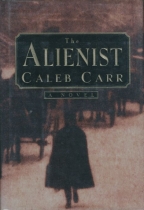 |
|
Caleb Carr's 'The Alienist' set a new standard for gritty, entertaining historical mystery. It was a novel embraced by many fans of genre fiction. |
|
|
|
The Agony Column for August 29, 2002
Commentary by Rick Kleffel
With New York as the talk of the towns, it's not surprising to find a couple of fantastic new novels with this city as their setting. What's surprising is that it's not New York of the 21st century -- or even the 20th century -- that gets the nod. These novels take the reader to 19th century New York. It's gas lamps, buggies, horses and pigs in the streets. From 1835 to 1896, these novels re-create a city utterly foreign to the present-day reader. The writers must build brick by brick a city now lost to the world. The environment is so different that at times, the reader will feel as if the author is engaged in the science-fictional process of world building.
Novels set in New York, historical or contemporary, are not all that unusual. But both Alexander Irvine's first novel, 'A Scattering of Jades' and Jeffrey Ford's 'The Portrait of Mrs. Charbuque' share a weird sensibility that sets them apart from the pack. They're definitely packed with historical details, realistic locales and historical figures brought skillfully to life. Lots of solid research went into the creation of these worlds. But both benefit from the author's imaginative touch that puts these novels a cut above the many imitators of 'The Alienist'.
 |
|
Caleb Carr's 'The Alienist' set a new standard for gritty, entertaining historical mystery. It was a novel embraced by many fans of genre fiction. |
Caleb Carr's 1994 novel was a pretty big event in the weird intersection of genre fiction. He was pretty much unknown, though he was the author of two previous books, 'The Devil Soldier' and 'Casing the Promised Land', and co-author with James Chace of 'America Invulnerable'. American publishing doesn't get a lot of room to talk about itself, and if it does, it's usually in association with movie adaptations of books. It's interesting to think of the author of three books as should be regarded as unknown.
Carr's 'The Alienist' changed all that. Set in New York in 1896, 'The Alienist' had the picture perfect combination of strangeness and familiarity, of gritty reality and horrific violence to strike a chord with the reading public. Easily one of the most "recommendable" books you can find on any shelf, it harkens back to Sherlock Holmes while infusing the historical novel with a dripping-slime sensibility straight out of 'Silence of the Lambs'. When a boy prostitute is found murdered and mutilated, newly appointed police commissioner Theodore Roosevelt enlists the men who found him in the investigation. Laszlo Kreitzler, the 'alienist' of the title is a psychologist in a time when psychology is regarded with suspicion. Together with reporter John Schuyler Moore (who tells the story) and police secretary Sara Howard, they search for the murderer by attempting to create a profile of the man based on the details of his crimes.
It's a tribute to Carr's skill as a prose writer that he manages to avoid hokey anachronism and integrate real personages into his fictional narrative. He does this by keeping the novel dense, a bit hard to follow and very, very dark. This is not a novel for the squeamish or softhearted. 'The Alienist' succeeds in large part by virtue of Carr's creation of New York. The city is so different from that which we know today that it seems likes he's using world-building toolkit of the science fiction writer. Though there is no element of science fiction or the supernatural in 'The Alienist', it has the feel of a genre novel.
Of course there's a great Hollowood horror story associated with the novel as well. Writer-director Philip Kaufman spent two years trying to write a screenplay that captured the complex ambience of the novel. Before he started, he was hesitant, and specifically asked his backers if they wanted a big-budget movie about a serial killer who prey on male child prostitutes. They ostensibly agreed, until he showed them the (now it seems cheap) price tag for the movie. The author now describes the whole experience as they typical film-deal nightmare, but for the $750,000 he made from it.
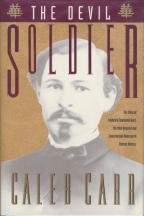 |
|
Caleb Carr's 'the Devil Soldier' was also optioned for a movie that was never made. Pierce Brosnan was pegged for the lead. |
Carr's previous book, 'The Devil Soldier' is a non-fiction work about the Chinese military campaigns of Frederick Townsend Warner, an American adventurer who built an army of Western-trained Chinese soldiers to defend Shanghai from the Taipings in 1859. While I actually found it in the remainder shelves of some now-extinct mega-bookstore (look upon my bookshelves, ye mighty chains, and despair), I did have some vested interest in its subject. As it happens, my grandmother built the mansion in Shanghai which currently houses the secret police. My parents discovered this back in the 1980's, when they visited China. After taking pictures of his mother's house, policemen took my father's camera away from him, removed the film and informed him that he was not to take pictures of the secret police HQ.
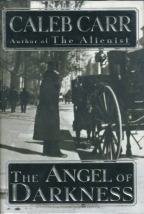 |
|
This novel got a rather lukewarm reception, but I really enjoyed it. Still, it is a sequel and not shint and new as was 'The Alienist'. |
'The Angel of Darkness' was Carr's follow-up to 'The Alienist'. To my mind, it was nearly as good, lacking only the 'shiny new writer and milieu' feel that 'The Alienist' brought to the party. 'The Angel of Darkness' takes place one year after 'The Alienist', when the United States is on the verge of war with Spain. A Spanish diplomat's daughter is kidnapped, and Kreitzler and company are called in to help. The twist that Carr provides is to have Stevie Taggart, a street kid enlisted by Kreitzler in 'The Alienist', tell the story. It does suffer from some signs of "sequelitis". It's longer. It's slower. It takes nearly a hundred pages before the killer --and there is killer -- makes their presence known. But for those who loved 'The Alienist', it's certainly recommended reading.
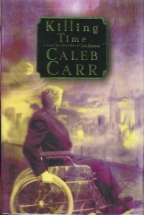 |
|
This near future SF novel sounded really promising until the reviews started coming in. I'm saving it for a rainy day. |
On the other hand, Carr's following novel, 'Killing Time', while it sounds very appealing was so roundly dissed that I could never actually bring myself to read the hardcover I bought as soon as it came out. In the first place, it was serialized in 'Time' magazine. One could not ask for vaster exposure. It was an unprecedented move. And it certainly helped to sour this reader on the author. The novel itself is a near-future science fiction story about digitally-manipulated media as the crux for a conspiracy to control the world. The general tenor of the reaction was that Carr should get back to the past. Alas, political events have brought him to write military interpretations of the "terrorist threat". I'm still waiting for the next Laszlo Kreitzler novel.
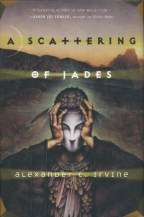 |
|
Alexander Irvine's 'A Scattering of Jades' is sure to impress fans of Tim Powers' 'The Anubis Gates'. In fact, it will impress just about anyone who reads it. |
But with Alexander Irvine and Jeffrey Ford filling the void, that wait has become a lot more bearable. In fact, I'm currently looking forward more to the next novels from these writers. Irvine's 'A Scattering of Jades' is set in a significantly earlier period than 'The Alienist'. It's 1835 in New York, and the Great Fire has just killed the wife and daughter of Archie Prescott, a typesetter who longs to write news. Seven years later, he's depressed, lonely, but still employed and on the verge of achieving his dream of becoming a writer. But asked by his publisher to watch P. T. Barnum, he stumbles upon a mystery that leads him to the Mammoth caves, Meso-American gods and his still-living daughter -- if only he can manage to save her. Irvine does an excellent job at creating the filthy streets of New York and a South still entrenched in slavery. This novel definitely has more than a touch of the surreal and the supernatural, excellently melded with the historical settings and characters. Irvine's plot is tense and his scenes are imaginative. Fans of Tim Powers 'The Anubis Gates' will find much to like here, and those science fiction and horror readers who loved 'The Alienist' should line up as well. This is Irvine's first novel and it bodes very well for this writer.
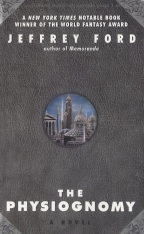 |
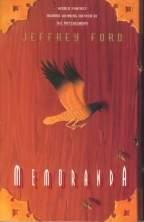 |
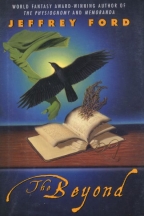 |
|
'The Physiognomy' was a fantastic debut from this talented author. |
Ford explores the techniques of building a memory palace in 'Memoranda' |
The monster tells the tale in the third book in this rough trilogy. |
'The Portrait of Mrs. Charbuque' is Jeffrey Ford's fourth novel. I've covered his previous novels in another column, but to summarize here: fantastic novels, great writing, great prose. The three books --'The Physiognomy', 'Memoranda' and 'The Beyond' -- comprise a rough trilogy, and should probably be read in the order they were written. But they should definitely be read; few writers have done as good a job of creating "everyday fantasy" as has Ford in these novels. They're very original bits of world building that deserve a wider audience. Ford has been compared to Kafka so many times he's included a story about in his collection 'The Fantasy Writer's Assistant'.
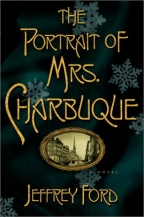 |
|
This book deserves awards and bestseller status. Buy it for a friend, or somebody you want to be your friend. |
Set in New York in 1893, 'The Portrait of Mrs. Charbuque' is not a science fiction, fantasy or horror novel. There are no elements of unreality in the book other than the lies told by his characters. In 'The Portrait of Mrs. Charbuque', Piero Piambo, a portrait painter, is offered a unique commission. He's going to make more from a single portrait than he might for a year's worth of depicting New York's spoiled upper crust. But his client has an odd request; he's never to look up on her. She will remain hidden behind a screen and tell him the story of her life while he sketches and paints. If his creation resembles the real thing, his fee will be doubled.
The resemblance of the story to that of Scheherazade is obvious, and Ford lives up to the high standards he has set for himself. His plot and characters are fascinating, and the novel is filled with stories within stories and wonderful prose. It's funny and highly-imaginative without ever becoming genre fiction. As Piambo works on his portrait, a mystery unfolds that involves Piambo, Charbuque, and the entire city. Ford keeps the prose and characterization outstanding but manages to create a compelling, page-turning literary work. This novel even shares a historical character with 'The Angel of Darkness', the painter Albert Pinkham Ryder. The only reason why this novel is not a bestseller is that it's pretty hard to find, and only vaguely publicized. It's even more recommendable than 'The Alienist', since it has no lingering scenes of dripping horror. All it has, all it needs is a great writer, a great story, and the ever-present wonder of New Old New York.
Thanks,
Rick Kleffel